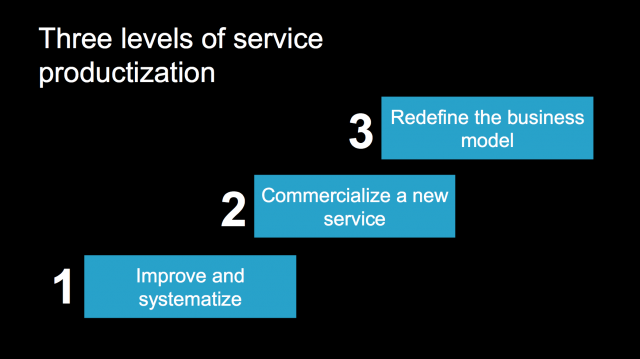If you’re running a small design firm and would like to increase your productivity, consider productizing your services.
I just gave a presentation at the Business of Architecture Summit on service productization. I quoted Jorma Sipilä, a Finnish consultant, who wrote: “A service is productized when it can be licensed or its ownership can be traded.” That statement summarizes the idea perfectly.
Even if you’re not planning to sell your business in the near future, productization has a lot to offer. The overall productivity of well-documented, repeatable business processes is better than doing everything differently every time. You free up time and resources for real value creation. Clients can be confident that they get consistent service delivery every time.
The three levels of productization
There are three levels of service productization:
- Improved and systematized processes
- New service products that supplement your existing services
- A completely new business model
Most companies start at level one. They develop templates, design libraries, model documents, databases, and so on. They systematize processes and use online tools for marketing, sales, and communication during projects.
Level two development requires both new services and new business planning. A typical new service precedes the design process. It is, for example, a pre-study, a training course, or a needs analysis.
Level three productization is the most radical. It will transform your business. An architect becomes a software developer; an engineer takes up management consulting; an interior designer starts a turnkey design-and-build business.

How to start the change
Whatever the level of productization, it is not easy to develop something new when you’re fully engaged in client projects. How can you find the time to plan and implement new ways of doing business?
I suggest that you start an internal development project. Even if you’re a solo entrepreneur, it makes sense to plan and execute your very own development project.
You already have the skills as a project professional. The model is simple:
- Set the goals and scope of your project
- Plan the project’s outcomes, tasks, and timing
- Define roles and responsibilities
- Set the milestones or checkpoints
- Allocate resources (time and money) and, if needed, hire external help
- Start off
Once you’re committed to a project, it is easier to set aside some time for it, even if you’re busy doing billable hours.
It is a good practice to involve someone from outside your company to keep track of your progress. A mentor or consultant will encourage you and help if you get stuck.
View the original article and our Inspiration here


Leave a Reply